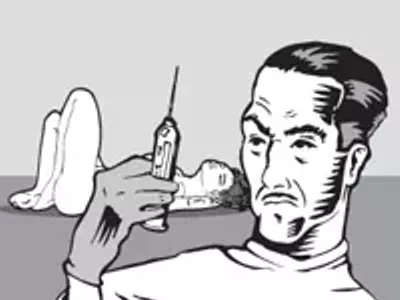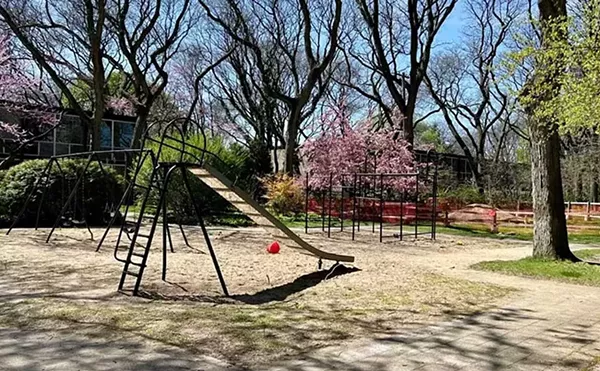
Audio By Carbonatix
[
{
"name": "GPT - Leaderboard - Inline - Content",
"component": "35519556",
"insertPoint": "5th",
"startingPoint": "3",
"requiredCountToDisplay": "3",
"maxInsertions": 100,
"adList": [
{
"adPreset": "LeaderboardInline"
}
]
}
]
Charity can come in many ways, though it often involves money changing hands. That money-changing ranges from huge multimillion-dollar national operations to the panhandler with palm outstretched for a few coins.
My favorite charity event is a small, rather informal thing. It was created five years ago by my friend Barbara Williams and her friend Leslie Vance. Williams, who recently retired from Detroit Public Libraries, found some toys in her basement that her grandson, an only child, had never opened. In gathering them up she thought why should one child have so much when others don't have anything at all? After calling around she decided to donate the toys to the Capuchin Service Center. While driving over with Vance, the two decided they should do more by tapping family and friends.
Williams and Vance started sending out about 50 letters to friends asking for $25 to buy toys. Some people give a little more, some don't give at all, but the take is around $1,200. Some of those who donate get together on a Saturday in early December, have a leisurely breakfast and go shopping at a Toys "R" Us store. You pay for your own breakfast. Every penny of the money collected goes to buy toys.
This year, my daughter and I joined the breakfast and went shopping. Children are key members of the shopping group as advisers on what to get. The shoppers break up into teams shopping for three different age groups. My job was to be a free agent roaming the store looking for buy-one-get-one-free deals or sale items.
For the first three years, the booty went to the Capuchins, but last year the organization decided it wanted to focus on keeping children warm with coats, hats and gloves. "While that's a good thing," says Williams, "being mothers and grandmothers we thought it was important for kids to have toys. Nobody wants to go back to school and say they got gloves for Christmas."
So, starting last year, the toys go to American Indian Health and Family Services. We drove directly from the toy store to their modest facility on a residential street in southwest Detroit where Nikole Fox, a coordinator there, gave us a short tour. AIHFS is a nonprofit organization focused on delivering comprehensive health services to the Native American community. Like many community organizations they struggle on a shoestring, but there was evidence of great dedication to their work and pride in their heritage.
Part of their work is prevention of alcohol and tobacco abuse. Posters on the walls urge readers to keep tobacco sacred. I asked Fox about that.
"It's not traditional to smoke or chew tobacco," she said. "It's used in prayer ceremonies and given to others as a sign of respect when they do a presentation or sing a song."
They have a garden in the yard where they grow tobacco and other traditional plants and vegetables. Some of the dried tobacco stalks sat on a table in an assembly room. They were greenish-gray with lots of round seed pods on the stems. It didn't look or smell like I imagined tobacco would; the leaves were not as big as elephant ears. The difference from what I had seen in pictures and on television is, Fox says, that "commercial tobacco is full of chemicals and hormones." I was looking at a natural, and traditional, product.
The yard also had a sweat lodge used for traditional healing ceremonies. They are culturally appropriate enhancements to the behavioral and mental health counseling services they offer.
I'm told there are about 40,000 Native Americans in southeast Michigan, and the AIHFS helps a few thousand of them each year. Its funding is slim. There's no tribal affiliation or a casino bringing in the cash. The day we brought the toys in we found out that another group that had previously done so wasn't this year. Ours was the only aid of this kind they were getting.
Our contribution seemed like a drop of water in the ocean compared to the need. Still, it felt good to be able to do anything. And learning about the tobacco tradition was a gift for me. When you compare that to last week's report about some of the giant veteran's charities saying they gave less than one-third of the money collected to the beneficiaries — one group gave only a penny per dollar collected — it puts a shine on Williams' and Vance's modest efforts. It's not a nonprofit, there's no tax write-off, no paid staff — just people to people with nothing in between.
Politics in black and white took a bizarre turn last week when it came to light that civil rights elder Andrew Young said that "Bill is every bit as black as Barack" — as in Clinton and Obama. Young added that Clinton has "probably gone with more black women than Barack." The former ambassador to the United Nations immediately claimed he was clowning, but it was a dead serious shot in a presidential race where Hillary Clinton's inevitable march to the Democratic nomination is being challenged by Obama in the mostly white states of Iowa and New Hampshire. Not that any of that has anything to do with either candidate's policies, but Bill Clinton's exploits with women, black or white, probably make him the Wilt Chamberlain of politics. And it's a sad, sexist-racist assertion to tie sexual exploits to racial bona fides. Now if Bill really is black, shouldn't Hillary receive the social stigma of a white woman who has gone over? ... Wait a minute, black conservative activist Shelby Steele asserted that "Hillary is blacker than Obama" on MNSBC's Hardball. This stuff is getting ridiculous, and it's going to get ridiculouser before it's over.
Speaking of white people who are black, based on the one-drop theory, DNA pioneer James Watson may have to change his sorry racist beliefs. Watson, who earlier this year claimed that Africans are less intelligent than whites, had his DNA analyzed. He was found to be 16 percent African — about the amount someone with a black great grandparent would have. The average European has less than 1 percent African DNA. Or could it be that Watson's 9 percent Asian DNA trumps his African content? After all, we know them people is real smart. Hey, if Bill and Hillary get their genomes analyzed maybe we can find out what they are and put all the speculation to rest.
What's Ike got to do with it? Plenty when it comes to freaky distorted rock guitar playing. Ike Turner, who died last week at age 76, discovered distortion when a bandmate played guitar through a broken amplifier during a recording session for "Rocket 88," a huge hit in 1951. Turner went on to become one of the earliest freak-out guitar players of rock 'n' roll. Although it's no excuse, he wasn't the only musician to take drugs and smack his wife around. However, when Tina Turner wrote a book that was made into the movie What's Love Got to Do with It, Ike became the poster boy for domestic violence. Laurence Fishburne, who played Ike in the movie, did that shit too good.






